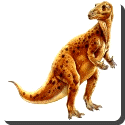 Iguanodon — Iguanodon is a genus of ornithopod dinosaur that lived roughly halfway between the first of the swift bipedal hypsilophodontids and the ornithopods’ culmination in the duck-billed dinosaurs. Most Iguanodon species lived between 140 to 120 million years ago, in the Valanginian to Barremian ages of the Early Cretaceous Period of Europe, although possible remains are known from North America, Asia, and Africa. Iguanodon’s most distinctive features were its large thumb spikes, which were possibly used for defence against predators.
Iguanodon — Iguanodon is a genus of ornithopod dinosaur that lived roughly halfway between the first of the swift bipedal hypsilophodontids and the ornithopods’ culmination in the duck-billed dinosaurs. Most Iguanodon species lived between 140 to 120 million years ago, in the Valanginian to Barremian ages of the Early Cretaceous Period of Europe, although possible remains are known from North America, Asia, and Africa. Iguanodon’s most distinctive features were its large thumb spikes, which were possibly used for defence against predators.
Discovered in 1822 and described three years later by English geologist Gideon Mantell, Iguanodon was the second dinosaur formally named, after Megalosaurus. Together with Megalosaurus and Hylaeosaurus, it was one of the three genera originally used to define Dinosauria. A large, bulky herbivore, Iguanodon is a member of Iguanodontia, along with the duck-billed hadrosaurs. The taxonomy of this genus continues to be a topic of study as new species are named or long-standing ones reassigned to other genera.
Scientific understanding of Iguanodon has evolved over time as new information has been obtained from the fossils. The numerous specimens of this genus, including nearly complete skeletons from two well-known bonebeds, have allowed researchers to make informed hypotheses regarding many aspects of the living animal, including feeding, movement, and social behaviour. As one of the first scientifically well-known dinosaurs, Iguanodon has occupied a small but notable place in the public’s perception of dinosaurs, its artistic representation changing significantly in response to new interpretations of its remains.
Iguanodon was a bulky herbivore that could shift from bipedality to quadrupedality.The best-known species, I. bernissartensis, is estimated to have weighed about 3.08 tonnes (3.5 tons) on average,and measured about 10 metres long (32.8 feet) as an adult, with some specimens possibly as a long as 13 metres (42.6 ft).Other species were not as large; the similarly robust I. dawsoni is estimated at 8 metres long (26.2 ft), and its more lightly-built contemporary I. fittoni at 6 metres (19.7 ft). This genus had a large, tall but narrow skull, with a toothless beak probably covered with keratin, and teeth like those of an iguana, but much larger and more closely packed.
The arms were long (up to 75% the length of the legs in I. bernissartensis) and robust, with rather inflexible hands built so that the three central fingers could bear weight. The thumbs were conical spikes that stuck out away from the three main digits. In early restorations, the spike was placed on the animal’s nose. Later fossils revealed the true nature of the thumb spikes,although their exact function is still debated. They could have been used for defence, or for foraging for food. The little finger was elongate and dextrous, and could have been used to manipulate objects. The legs were powerful, but not built for running, and there were three toes on each foot. The backbone and tail were supported and stiffened by ossified tendons, which were tendons that turned to bone during life (these rod-like bones are usually omitted from skeletal mounts and drawings). Overall, in body structure, it was not too dissimilar from its later relatives, the hadrosaurids.
One of the first details noted about Iguanodon was that it had the teeth of a herbivorous reptile, although there has not always been consensus on how it ate. As Mantell noted, the remains he was working with were unlike any modern reptile, especially in the toothless, scoop-shaped form of the lower jaw symphysis, which he found best compared to that of the two-toed sloth and the extinct ground sloth Mylodon. He also suggested that Iguanodon had a prehensile tongue which could be used to gather food, like a giraffe. More complete remains have shown this to be an error; for example, the hyoid bones that supported the tongue are heavily built, implying a muscular, non-prehensile tongue used for moving food around in the mouth. The giraffe-tongue idea has also been incorrectly attributed to Dollo via a broken lower.
 Kids Portal For Parents India Kids Network
Kids Portal For Parents India Kids Network
